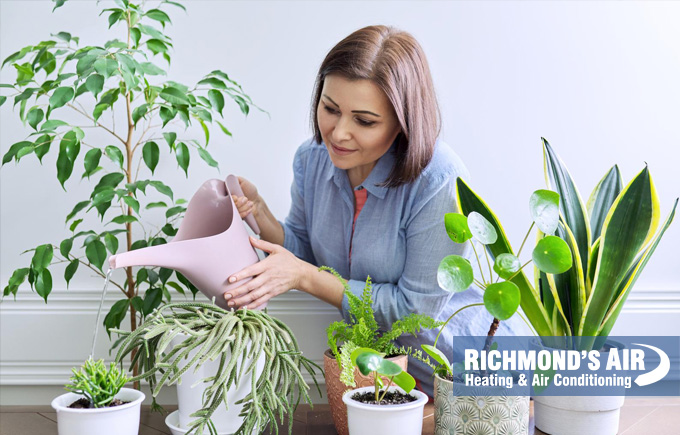Learn which plants are best at removing chemicals and improving the air quality in your home
Have you ever wondered about the air quality in your home? Indoor air quality is a measure of how clean and healthy the air is inside your home. If you have poor indoor air quality, it can lead to a number of health problems, such as asthma and allergies.
Indoor air pollution often results from poor ventilation and can be affected by various factors like humidity, temperature, mold and dust particles.
Common sources of indoor air pollution
Below are some common sources of air pollution in many of our homes.
Petroleum candles
Burning candles is a popular method of scenting indoor air. While these candles may provide a pleasing fragrance, they also emit pollutants that can be harmful to your health. The most common type of candle used in homes is the paraffin candle, which emits several different types of pollutants.
Paraffin wax candles release soot, carbon monoxide (CO), carbon dioxide (CO2), nitrogen oxides (NOx), and volatile organic compounds (VOCs). The soot that paraffin wax candles emit can cause respiratory problems and lung cancer when inhaled over long periods of time.
Additionally, carbon monoxide can build up in poorly ventilated rooms and affect the cardiovascular system by reducing oxygen delivery to vital organs like the brain and heart.
Air fresheners
Air fresheners can also be a source of indoor air pollution. Many of them use chemicals that are volatile organic compounds (VOCs), including formaldehyde, which can cause irritation, dizziness and headaches. Formaldehyde is also known to trigger allergies, asthma attacks and nosebleeds in those who are sensitive to it. VOCs can also exacerbate asthma symptoms in people with a history of asthma.
The types of VOCs emitted from air fresheners mainly depend on the ingredients used in their fragrances. Unfortunately, it’s nearly impossible to know which ingredients are used in a particular air freshener because most manufacturers don’t list them, as they’re not required to do so.
Cooking
Cooking can pollute our indoor environment because most people tend to cook with gas, electricity or wood, which all generate indoor air pollution.
Carbon dioxide is produced if you burn wood or use a propane or natural gas stove. Carbon monoxide is a poisonous gas that kills your red blood cells, making you feel tired and weak.
When cooking with oil, there are 2 main sources of pollution: Burning oil produces carbon monoxide just like burning wood does, and it also produces fumes from the oil itself, which can irritate the lungs and make breathing difficult for people with asthma.
How does poor indoor air quality affect your health?
Sick building syndrome is an illness that occurs in a building or home and is caused by off-gassing or the release of toxic chemicals. Off-gassing occurs when volatile organic compounds (VOCs) emitted from materials such as paints, candles and carpets are trapped inside a building.
The symptoms of sick building syndrome can be similar to those of other illnesses, so it can be difficult to diagnose. Common symptoms include:
- Headaches
- Dizziness
- Nausea
- Fatigue
- Skin rashes and hives
- Breathing problems
- Eye irritation
- Difficulty concentrating
If you’re experiencing these symptoms and are concerned about your indoor air quality, first talk to your doctor, then consider having the air quality in your home checked by an HVAC specialist.
Can houseplants improve indoor air quality?
One way to improve the air quality in your home is to add plants into the mix because they can absorb toxic gasses, such as carbon dioxide, formaldehyde, and benzene, from the air, and they also add oxygen to your home.
The following houseplants are known for their ability to remove toxins and create healthier indoor air.
Areca palm
This plant helps to remove formaldehyde from the atmosphere, which is present in many building materials. It’s also effective at removing xylene and trichloroethylene from the air. It is easy to grow but should be kept away from direct sunlight when young because it can get sunburned easily.
Snake plant
This plant is ideal for removing carbon dioxide from the atmosphere as well as absorbing ammonia, benzene, formaldehyde and xylene. The snake plant grows well in low light conditions, so it’s perfect for offices or apartments with little natural light.
Gerbera daisy
People tend to associate gerbera daisies with funerals, but they’re actually great at removing harmful chemicals from the air in your home. In fact, researchers have found that this plant is capable of reducing benzene levels in a room by up to 95 percent.
Spider plant
Spider plants are low-light, low-maintenance plants that help remove carbon monoxide and xylene from the air. They’re also pet friendly, so they’re good for you as well as your four-legged friends.
Weeping fig (Ficus Benjamina)
The weeping fig grows in a vine-like shape with long branches covered in leaves that resemble ficus leaves. It filters formaldehyde, benzene and trichloroethylene (TCE) from indoor air.
Chrysanthemum
The chrysanthemum is one of the most popular flowering plants. It can help remove benzene and formaldehyde from the air in your home.
Aloe vera
In addition to soothing burns, aloe vera is also great at reducing toxins in your home. Aloe vera has been shown to reduce carbon monoxide and formaldehyde levels in homes when grown indoors. The key is making sure you have enough light for this plant since it needs bright sunlight to thrive.
Money plant
Money plant is a great indoor plant for improving air quality. The money plant cleans the air by removing formaldehyde, benzene, xylene, toluene and trichloroethylene from the air. It’s an adaptable plant that can thrive in both low- and high-light environments.
Chinese evergreens (Aglaonema spp.)
Chinese evergreens are one of the most popular houseplants around because they’re easy to care for and don’t require much light or water. They can help remove benzene from your home, which is great news for anyone who has an oil-burning heater or stove in their kitchen.
Broad lady palm (Cyperus alternifolius)
This plant is native to Africa and has large leaves that can grow up to 4 feet long. The broad lady palm removes chemicals from the air by absorbing them through its leaves, earning itself the nickname the “air purifier plant.”
Red-edged dracaena (Dracaena marginata)
The red-edged dracaena is a slow-growing plant with slender leaves that can reach up to 6 feet. It’s one of the best plants for filtering formaldehyde and benzene from the air.
Rubber plant (Ficus elastica)
The rubber plant is a hardy, versatile plant that helps remove benzene, trichloroethylene, xylene and formaldehyde.
Contact an HVAC specialist to help improve the air quality in your home
If you want additional help improving the air quality in your home and you live in the Houston area, contact the experienced HVAC specialists at Richmond’s Air. We can service your current system or help you explore your options if you’re ready for an upgrade. We can also help you schedule regular preventive maintenance and a system tune-up each year.
 Read reviews
Read reviews








